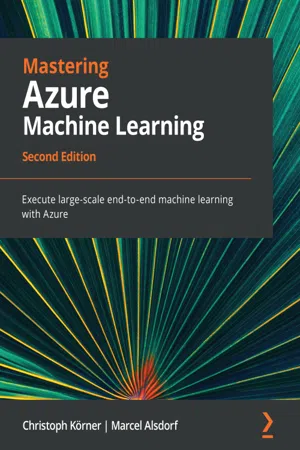
- 624 pages
- English
- ePUB (mobile friendly)
- Available on iOS & Android
Mastering Azure Machine Learning
About this book
Supercharge and automate your deployments to Azure Machine Learning clusters and Azure Kubernetes Service using Azure Machine Learning servicesKey Features• Implement end-to-end machine learning pipelines on Azure• Train deep learning models using Azure compute infrastructure• Deploy machine learning models using MLOpsBook DescriptionAzure Machine Learning is a cloud service for accelerating and managing the machine learning (ML) project life cycle that ML professionals, data scientists, and engineers can use in their day-to-day workflows. This book covers the end-to-end ML process using Microsoft Azure Machine Learning, including data preparation, performing and logging ML training runs, designing training and deployment pipelines, and managing these pipelines via MLOps. The first section shows you how to set up an Azure Machine Learning workspace; ingest and version datasets; as well as preprocess, label, and enrich these datasets for training. In the next two sections, you'll discover how to enrich and train ML models for embedding, classification, and regression. You'll explore advanced NLP techniques, traditional ML models such as boosted trees, modern deep neural networks, recommendation systems, reinforcement learning, and complex distributed ML training techniques - all using Azure Machine Learning. The last section will teach you how to deploy the trained models as a batch pipeline or real-time scoring service using Docker, Azure Machine Learning clusters, Azure Kubernetes Services, and alternative deployment targets. By the end of this book, you'll be able to combine all the steps you've learned by building an MLOps pipeline.What you will learn• Understand the end-to-end ML pipeline• Get to grips with the Azure Machine Learning workspace• Ingest, analyze, and preprocess datasets for ML using the Azure cloud• Train traditional and modern ML techniques efficiently using Azure ML• Deploy ML models for batch and real-time scoring• Understand model interoperability with ONNX• Deploy ML models to FPGAs and Azure IoT Edge• Build an automated MLOps pipeline using Azure DevOpsWho this book is forThis book is for machine learning engineers, data scientists, and machine learning developers who want to use the Microsoft Azure cloud to manage their datasets and machine learning experiments and build an enterprise-grade ML architecture using MLOps. This book will also help anyone interested in machine learning to explore important steps of the ML process and use Azure Machine Learning to support them, along with building powerful ML cloud applications. A basic understanding of Python and knowledge of machine learning are recommended.
Frequently asked questions
- Essential is ideal for learners and professionals who enjoy exploring a wide range of subjects. Access the Essential Library with 800,000+ trusted titles and best-sellers across business, personal growth, and the humanities. Includes unlimited reading time and Standard Read Aloud voice.
- Complete: Perfect for advanced learners and researchers needing full, unrestricted access. Unlock 1.4M+ books across hundreds of subjects, including academic and specialized titles. The Complete Plan also includes advanced features like Premium Read Aloud and Research Assistant.
Please note we cannot support devices running on iOS 13 and Android 7 or earlier. Learn more about using the app.
Information
Section 1: Introduction to Azure Machine Learning
- Chapter 1, Understanding the End-to-End Machine Learning Process
- Chapter 2, Choosing the Right Machine Learning Service in Azure
- Chapter 3, Preparing the Azure Machine Learning Workspace
Chapter 1: Understanding the End-to-End Machine Learning Process
- Grasping the idea behind ML
- Understanding the mathematical basis for statistical analysis and ML modeling
- Discovering the end-to-end ML process
Grasping the idea behind ML
Problems and scenarios requiring ML

Table of contents
- Mastering Azure Machine Learning
- Second Edition
- Preface
- Section 1: Introduction to Azure Machine Learning
- Chapter 1: Understanding the End-to-End Machine Learning Process
- Chapter 2: Choosing the Right Machine Learning Service in Azure
- Chapter 3: Preparing the Azure Machine Learning Workspace
- Section 2: Data Ingestion, Preparation, Feature Engineering, and Pipelining
- Chapter 4: Ingesting Data and Managing Datasets
- Chapter 5: Performing Data Analysis and Visualization
- Chapter 6: Feature Engineering and Labeling
- Chapter 7: Advanced Feature Extraction with NLP
- Chapter 8: Azure Machine Learning Pipelines
- Section 3: The Training and Optimization of Machine Learning Models
- Chapter 9: Building ML Models Using Azure Machine Learning
- Chapter 10: Training Deep Neural Networks on Azure
- Chapter 11: Hyperparameter Tuning and Automated Machine Learning
- Chapter 12: Distributed Machine Learning on Azure
- Chapter 13: Building a Recommendation Engine in Azure
- Section 4: Machine Learning Model Deployment and Operations
- Chapter 14: Model Deployment, Endpoints, and Operations
- Chapter 15: Model Interoperability, Hardware Optimization, and Integrations
- Chapter 16: Bringing Models into Production with MLOps
- Chapter 17: Preparing for a Successful ML Journey
- Other Books You May Enjoy